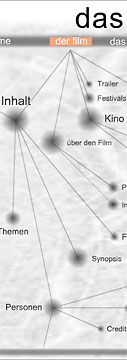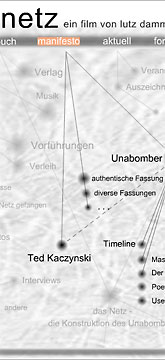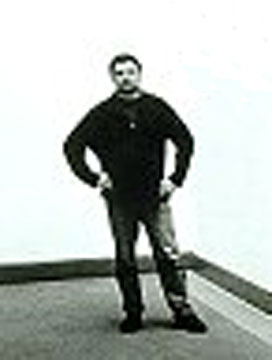Das Netz re(inter)view
20 Oct 2005
www.t-h-e-n-e-t.com/
www.expolar.de/kybernetik/
Review – The Dark Side : Das Netz : ein Film von Lutz Dammbeck
 Lutz Dammbeck’s Das Netz is a highly commendable and intriguing work of research, drawing from Internet, archival and interview sources, in which we are taken on a journey to examine early Internet history and its less savory or more hedonistic, cultish and covert government protected aspects. Themes generally underexplored in the Net’s military, artistic and industry lineage are brought to life in Das Netz. It is a deeply thought-provoking documentary deftly weaving an abundance of esoteric information into numerous pernicious subplots for a moving picture of the most innovative largely American, if not Californian and “white privileged male” communications tool to date.
Lutz Dammbeck’s Das Netz is a highly commendable and intriguing work of research, drawing from Internet, archival and interview sources, in which we are taken on a journey to examine early Internet history and its less savory or more hedonistic, cultish and covert government protected aspects. Themes generally underexplored in the Net’s military, artistic and industry lineage are brought to life in Das Netz. It is a deeply thought-provoking documentary deftly weaving an abundance of esoteric information into numerous pernicious subplots for a moving picture of the most innovative largely American, if not Californian and “white privileged male” communications tool to date.
“What is it that hippies, LSD, and computers have in common?” queries Dammbeck at the start.
In later probes he takes up alliances between European postwar intellectuals from Norbert Wiener to Heinz von Foerster and their anti-fascist beliefs; delving momentarily into a document published by the Frankfurt School on the “totalitarian personality” and its curious influences on a secret history of research known as the Macy Conferences. Designed to study the workings of the human mind and its authoritarian social psychology, these Conferences invited Margaret Mead, Norbert Wiener and psychologist Kurt Lewin, among others and later, avant-garde artists such as John Brockmann, Stuart Brand, John Cage, and Buckminster Fuller to exchange views on hippy generation concepts such as “mind expansion”, open systems and human consciousness. These Macy undertakings wound up influencing a period of psyop testings most notably performed by Dr. Henry A. Murray at Harvard University on Ted Kaczynski – elsewise known as “the Unabomber” – as well as the CIA’s MK Ultra project.
At the cross roads of Dammbeck’s journey is a continuous theme – one of the counter culture’s technology v. anti-technology sentiments – most directly expressed in footage of the Whole Earth Catalog’s pages shot to show the hawking of the alternative lifestyle of the “the sixties” – everything from pamphlets on how to farm your own goat’s milk to how to build a log cabin in the wilderness; to ads for the personal computer. This romantic and utopian counter culture of “back to nature” and escape from civilization ; is poignantly addressed by Dammbeck’s lengthy foray into Ted Kaczynski’s criminal activities and involvement in Murray’s psyops testing while a promising Harvard math student.
 In conclusion, Das Netz seeks to explore the varied social philosophies contributing to the parallel development of the Internet. With the filmmaker’s extensive research, this work opens up dialogue around the Net’s arrival as a broadly conceived and arguably, “experimental” tool. The film, however, omits naming any fundamental and vital connection between countercultural consciousness and the pursuit of a techno-utopia; the era of Howard Rheingold’s Virtual Community, notions of the digital commons and “information wants to be free” – or even to elaborate on the extraordinary meaning of “the Well” (Whole Earth eLectronic Link) – a conceptual groundwork essential to the Internet culture wars and cybercultures as they stand today.
In conclusion, Das Netz seeks to explore the varied social philosophies contributing to the parallel development of the Internet. With the filmmaker’s extensive research, this work opens up dialogue around the Net’s arrival as a broadly conceived and arguably, “experimental” tool. The film, however, omits naming any fundamental and vital connection between countercultural consciousness and the pursuit of a techno-utopia; the era of Howard Rheingold’s Virtual Community, notions of the digital commons and “information wants to be free” – or even to elaborate on the extraordinary meaning of “the Well” (Whole Earth eLectronic Link) – a conceptual groundwork essential to the Internet culture wars and cybercultures as they stand today.
Few films take up the subject of the Net in any seriousness. With the exception of Revolution OS a lengthy essay on the open source movement focusing on Richard Stallmann, Linus Torvald, Steve Wozniak, and numerous others, all interviewed, there are really none of much merit. In this context, it is the brilliant collection of interviews conducted by Dammbeck himself for Das Netz – where we get John Brockmann, Stewart Brand, Bob Taylor, Heinz von Foerster, and David Gelerntner which contribute to an outstanding cinematic cyberhistory and which draw connections rarely made between the worlds of cybernetics and ARPANet; Unabomber victims and their achievements; social theory and “the California effect”. The film’s appeal is as this original and relevant untold story – referencing many, many artists and thinkers, Das Netz is a must see for creative network enthusiasts and those interested in cyber theory, post cold war history or similar subject matter.
Interview
 Molly Hankwitz: Your film is an elaborate researchive journey and very impressive in this respect. I’m assuming that the film has screened already in Germany and maybe other parts of Europe? What has been the reception of such a California-American-based interpretation of the history of the Net in Europe? Has there been any significant response from this perspective given that the Internet has had such a long history in Europe and the California effect has come under criticism?
Molly Hankwitz: Your film is an elaborate researchive journey and very impressive in this respect. I’m assuming that the film has screened already in Germany and maybe other parts of Europe? What has been the reception of such a California-American-based interpretation of the history of the Net in Europe? Has there been any significant response from this perspective given that the Internet has had such a long history in Europe and the California effect has come under criticism?
Lutz Dammbeck: Of course, the history of the technological net[work]s is known to specialists in Germany or Europe. But almost certainly, the wider public was not as aware of the extent to which the USA and its military-technological complex triggered, forced, and determined their development. It was certainly new to direct attention towards the help that was given by counter-culture, art, sociology, and interdisciplinary arts, which one would have expected to have been more left-wing.
At its screenings in Germany and Europe, therefore, the film was not seen initially as a “California-based history of the net” at all (please remember that a lot of all these inventions in art and science came from the old Europe, New Bauhaus, and others), but as a provocative bringing together of people and political-philosophical standpoints that did not appear to belong together, and that risked the loss of their good name in the process. As one critic summed up:
In the film, figures such as John Cage, Theodor W. Adorno, Timothy Leary, Heinz von Foerster, and the gestalt psychologist Kurt Lewin are to be found alongside well-known pioneers of technology; surprisingly united in their efforts to liquidize existing values and fabricate a “post-national, multi-ethnic world society with no established borders, under the leadership of the USA.”
—[unattributed]
Indeed, after all my research, I recognize a coherent – and not only in the diagrammatic sense – track leading from Norbert Wiener’s “AA-Predictor” [anti-aircraft] and “Cybernetics” to concepts for “Worldwide Mental Health” and the “Politics of Containment” or the “Electronic Battlefield” during the Vietnam War (which was accompanied by the simultaneous – and sometimes equated – development of Multimedia and Concept Art). This path can be extended to the notions of an “owners’ society” that are pursued today in George W. Bush’s USA. The evident abolition, expulsion, and systematic destruction of any notions of solidarity that this involves, or of the institutions and achievements, say, of the workers’ movement, must also be regarded as a reflection of the anti-collective (and anti-communist) “atomism,” to which the participants at the Macy Conferences, for example, were so dedicated. The individual merely functions as “information” in an infinite cybernetic feedback loop – the most modern and up until now most effective form of a [concentration] camp.
So there was strong criticism in some press reviews, including insults such as “Dammbeck has the effrontery ...”, “in the style of paranoid Internet-blog idiots ...”, “Talibanist technology criticism from the perspective of the Unabomber, in the style of the GDR propaganda films of the 1960s ...” etc. These and other [vehement]1 reactions indicate that the film certainly hit a sore point. That is good on the one hand, of course, but on the other hand, I believe it may have closed some doors to the film, particularly in the USA.
In addition, the length, aesthetics, and entire conception of the film mean that it represents a quite deliberate polemic against current, fashionable forms of documentary à la Surplus (Surplus: Terrorized into being consumers. 2004.) or Michael Moore, which – consciously or unconsciously – transport and promote precisely the ideology that they claim to criticize.
However, the many, many discussions with audiences after my film were, by contrast to the more dogmatic and “ideologically” motivated attacks in the press, very open and interesting – especially when there were numerous technology freaks in the audience; people who are still very euphoric about technical possibilities and believe in them, and who have now been made to doubt.
Overall, I would say that up until now, the film appears to be functioning very well as a “restraining body”.
MH: You spend a lot of time in the film on the strange life and character of the Unabomber – which is very interesting and presents a complex relationship to the technological development of the Internet. Did you want your audiences to be at all sympathetic with him in any way? Do you yourself have any sympathy for him?
LD: Yes, a bit. What was it about Ted Kaczynski that particularly interested me? His apparently fundamental opposition. Of course, I could have made the film without him, by simply taking a look at the people who played important roles at the various points in the fields of computer studies, in the military, in alternative culture, in the art and science scenes etc. But the fundamental criticism that Kaczynski represents – and that is connected with his biography and the 1968 movement – is not simply theoretical; he also lived it with a certain consistency.
When I tried to contact him through a Concept Artist from Boston, I also came across some of the organizers and intellectuals behind the WTO protests in Seattle in 1999. They come from a big Punk-Hippie commune close to Seattle, and I became aware that Kaczynski was important to the precursors of the ATTAC-scene2 and was not just an Internet chimera. Stuart Brand, for example, sets him on the same level of discussion as Bill Joy.
So then I located the “Unabomber Manifesto” on the Internet and initiated our correspondence.
Whether the audience has any sympathies with Ted or not depends, on the one hand, on their own standpoints, but also on my presentation of his ideas, philosophy, and case. I wanted to be fair to him, as well as to the victims and his opponents. So that the viewer can decide for himself. Do I myself have any sympathy for his philosophy and terrorist practice? I think some things in his letters and in the Manifesto are logical, and he puts over some correct arguments. My limit is reached when violence is practiced against other people in a kind of “self-empowerment”. Whether it’s a matter of criticizing art (Otto Mühl), or society. But we are touching on many open questions here, to which I don’t know the answers, either. When Ted asks me, for example, whether I think that the Jews in the Warsaw ghetto had the right to use violence and kill the SS-men? And that he derives the same right to use violence from that.
But beyond intellectual debate and a general humane sympathy with his fate, it is difficult to have sympathy with someone that you have never seen or spoken to face-to-face.
All that remains is the exchange of letters, which is also tactical – on both sides. I want to make a good film, and he wants to use the opportunity to codetermine his image in this film, or at least as far as possible. In his letters, he is very correct, scientifically precise, sometimes witty, but also reprimanding and self-opinionated on occasion.
It is difficult for me to make further judgements or come up with a more precise characterization of him; even after three years of exchanging letters, that would be speculative.
In very general terms, I find his position “strange”, and impressive in its consistency, which even reaches the point of self-destruction. As an artist, naturally, it interests me when someone enters border areas, since that is what artists attempt every day, even trying to abolish the border between art and life, between the “real” and the “as if”.
MH: I have more questions for you – I’ve written a short review of your film which I liked very much, I will reiterate – I’m wondering what else you have made – there is probably a filmography somewhere but I’m wondering if there are certain films you could discuss which worked into Das Netz in some way, either as process or as thought or both. Style? Documentary approach? Could you discuss this?
LD: I am working on a kind of “synthesis of the arts” consisting of films, texts, pictures and collages, installations and photographs, entitled Heracles-Concept. I began this work in the GDR in 1982 and have been continuing it since then; it includes media collages made up of dance, film, music and painting, and texts by the dramatist Heiner Müller, for example. The film Das Netz is part of that work. At present, I am producing over 100 pictures and collages, for which I am using the research material; the “found footage”. It also includes the reconstruction of the “Unabomber-cabin”, which could already be seen in several exhibitions. Here is a quotation about that from Art in America 2004:
Anti-Utopias
The most convincingly realized installation in the “Berlin-Moscow” exhibition came from a German, Lutz Dammbeck, (19) who is unknown in the U.S. Dammbeck re-created Unabomber Ted Kaczynski’s Montana cabin as the latest manifestation of the “Hercules” project, his two-decade series of films, installations, theater and music examining the moral implications of the contemporary marriage of politics and technology. The unenterable cabin exerted an intense psychological pull; through the windows, one could watch the busy workings of computers and other space-age devices against which the Unabomber had conducted his terrorist campaign. On surrounding shelves for take-away were Kaczynski’s manifesto and excerpts from Norbert Wiener’s Cybernetics: or, Control and Communication in the Animal and the Machine, T.W. Adorno’s The Authoritarian Personality, and selected writings of Thoreau.
— Amei Wallach. “Berlin-Moscow: Cold War icons revisited: at the heart of a huge German-Russian cultural exchange, a 500-work show at the Martin-Gropius-Bau Berlin examined a half-century of confrontation between East and West.” Art In America. June-July 2004.
MH: I’m also wondering how or why you didn’t look at Howard Rheingold and the techno-utopians – even someone like Manuel Castells who is at Berkeley. By the way, if you ever decide to come back to the Bay Area for a visit or to make the next installment, Das Netz 2 : The Untold Story of Virtual Community ...
LD: Of course Howard Rheingold was a person whose biography and texts interested me during the shooting of the film. And Ted Nelson, for example, and naturally Minsky (who was, unfortunately, unwilling to give an interview), and also the Extropians, Doug Engelbart (already interesting enough because of his proximity to Stewart Brand), John Perry Barlow (whom I visited and interviewed), or Esther Dyson. The book by Barbrook/Cameron, The Californian Ideology, was also important for my preparations, and several journeys. Face-to-face is tremendously important for pre-shooting work.
And of course I found the whole story surrounding the “Dead-Heads” on Ken Kesey’s farm incredibly interesting – all that is an untold story, really.
Do you think I should tackle it – would anyone in the USA be interested?
Molly Hankwitzmollybh@netspace.net.au
◊
1. Original ‘hefty’, prob. as a false-friend translation for heftig
2. Association pour une Taxation des Transactions financières pour l'Aide aux Citoyens et Citoyennes : Association for the taxation of financial transactions for the benefit of all citizens. www.attac.org/indexen/index.html